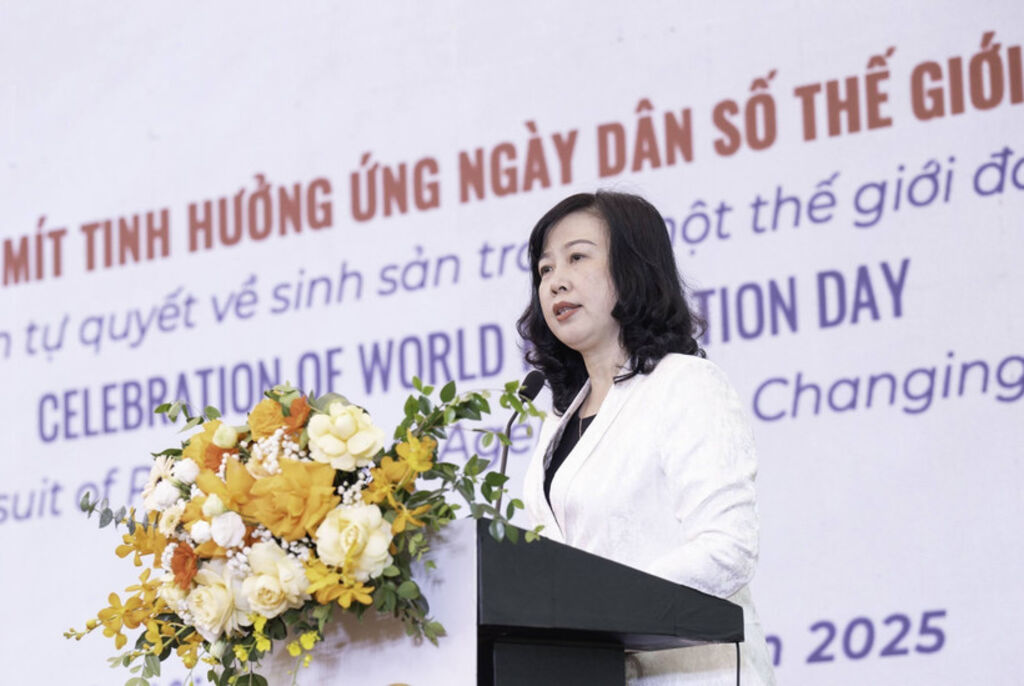 |
| Minister of Health Dao Hong Lan speaks at the meeting__Photo: VNA |
Minister of Health Dao Hong Lan highlighted Vietnam’s achievements in population management at a meeting in Hanoi on July 11 to commemorate World Population Day 2025 and release the State of the World Population Report 2025.
The event was organized by the Ministry of Health (MoH), in collaboration with the United Nations Population Fund (UNFPA) in Vietnam.
Lan, who also serves as deputy head of the National Committee for Population and Development, emphasized that the newly adopted revised 2025 Population Ordinance affirms individuals' and couples' rights to reproductive decision making in a manner that respects health conditions and personal circumstances. This is fully aligned with this year’s World Population Day theme of “Empowering young people to create the families they want in a fair and hopeful world”.
The Vietnamese Party and State have long prioritized population issues, as confirmed by Resolution 21-NQ/TW of the 12th Party Central Committee, which states that population is a critical factor in the cause of national construction and defense.
In line with Vietnamese law, “each couple or individual has the right to decide the timing, number of children, and spacing between births, taking into account age, health, education, work, income, and child-rearing capacity.” This regulation underscores the "empowerment of reproductive decision making."
The minister cited the control of population growth and the country’s current "golden population structure" phase, which supports socio-economic development. Improvements in living standards and income have contributed to an average life expectancy of 74.7 years by 2024, surpassing many nations with similar income levels. Vietnam's healthcare services, including reproductive health, family planning, pre-marriage counselling, and elderly care, have also seen continuous progress.
Looking ahead, the minister noted that the MoH is drafting the Population Law and the National Target Program on Health care, Population, and Development for 2026-2035. The goal is to ensure social security, health, and equality for all citizens, placing people at the heart of sustainable development.
Several key provisions in the draft Population Law, set to be presented to the National Assembly in October 2025, include maternity leave benefits, financial support for childbirth, prenatal and newborn screening, prioritized social housing access, and assistance for families with only daughters. Matt Jackson, UNFPA Representative in Vietnam, summarized the State of the World Population Report 2025 findings from a survey conducted across 14 countries. One in five people reported being unable to have the number of children they desire; economic barriers were cited as the main obstacle by over half of respondents; one-third had experienced unintended pregnancies; and 40 percent of those over 50 reported not achieving their desired family size.
He commended Vietnam’s efforts to uphold reproductive rights and reiterated UNFPA's commitment to supporting the Vietnamese government in drafting the Population Law and implementing the National Target Program on Health care, Population, and Development for 2026-35.
Since the 1994 International Conference on Population and Development (ICPD), Vietnam has made significant strides, contributing to the achievement of Sustainable Development Goals (SDGs). Population management has been key in driving economic growth, reducing inequality, promoting social progress, and improving quality of life. The National Statistics Office under the Ministry of Finance reported notable improvements in services related to reproductive health, family planning, pre-marriage counselling, birth defects screening, and elderly care.
Despite progress, Vietnam still faces challenges in meeting its population and development goals. These include a rapidly declining birth rate (in 2024, the fertility rate dropped to just 1.91 children per woman) and a rapidly ageing population. Vietnam is among the fastest ageing countries, due to the low birth rate. The imbalance in the sex ratio at birth remains high, and teenage pregnancies are on the rise.
The event highlighted Vietnam’s commitment to addressing these challenges, including its intent to collaborate with international organizations and the global community to combat low birth rates, rapid population ageing, and to promote reproductive rights and sustainable development.
Lan called for continued support and cooperation from government agencies, local authorities, and the international community to ensure the effective implementation of the Population Law and associated health programs in the years ahead.- (VNA/VLLF)









